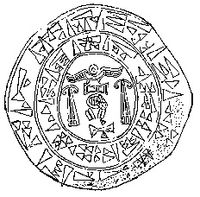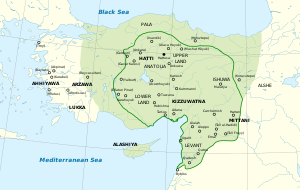شوپپيلوليئوما
شوپپيلوليئوما الأول (Suppiluliuma I ؛ /ˌsʌpɪlʌlɪˈuːmə/) أو Suppiluliumas I ( /ˌsʌpɪlʌlɪˈuːməs/[1]) was king of the Hittites (r. c. 1344–1322 BC (short chronology)). He achieved fame as a great warrior and statesman, successfully challenging the then-dominant Egyptian empire for control of the lands between the Mediterranean and the Euphrates.
| شوپپيلوليئوما | |
|---|---|
 شوپپيلوليئوما | |
| العهد | 1380 - 1334 ق.م. |
| تودحليا الثالث | |
| أرنوواندا الثاني | |
| وُلِد | 1358 ق.م. |
| توفي | 1321 ق.م. حاتوشا (بوغازقلعه) |
| مال نيكال و حنطي | |
| الأنجال | |
| الأب | تودحليا الثاني |
. . . . . . . . . . . . . . . . . . . . . . . . . . . . . . . . . . . . . . . . . . . . . . . . . . . . . . . . . . . . . . . . . . . . . . . . . . . . . . . . . . . . . . . . . . . . . . . . . . . . . . . . . . . . . . . . . . . . . . . . . . . . . . . . . . . . . . . . . . . . . . . . . . . . . . . . . . . . . . . . . . . . . . . .
العائلة
Suppiluliuma had two wives. The first wife who served as his queen was a woman named Henti. A badly damaged text from the reign of her son Mursili II implies that Queen Henti may have been banished by her husband to the land of Ahhiyawa. An advantageous marriage with a Babylonian Princess might have resulted in her banishment.[2] She is likely the mother of all of Suppiluliuma's sons.
- Arnuwanda II a king of the Hittite Empire (new kingdom) c. 1322–1321 BC
- Telipinu, who is known from a decree appointing him as a priest of Kizzuwadna.[2]
- Piyassili, later known as Sarri-Kusuh and governor of the former territory of Hanigabat west of the Euphrates
- Mursili II a king of the Hittite Empire (New kingdom) c. 1321–1295 BC
- Zannanza, the Hittite Prince who was sent to Egypt in response to the Dakhamunzu letter and possibly murdered en route.
After Henti's disappearance the next queen is a Babylonian princess named Malignal. She is the daughter of King Burna-Buriash II. Malignal adopts the title Tawananna as her personal name.[2]
Suppiluliuma is known to have had at least one daughter. Her name was Muwatti.[2]
|
المراجع:
- Trevor Bryce (1997). The Kingdom of the Hittites. Oxford, England: Clarendon Press.
- Trevor Bryce (2012). The World of the Neo-Hittite Kingdoms. Oxford, England: Oxford University Press.
- Volkert Haas (2006). Die hethitische Literatur. Berlin, Germany: de Gruyter.
ملاحظات:
- ^ Scholars have suggested that Tudhaliya I/II was the son of Himuili and thus a grandson of the Hittite king Huzziya II (Bryce 1997, p. 131).
- ^ Bryce (1997) does not consider it clear whether Tudhaliya I/II was one king or two (p. 133).
- ^ أ ب ت Bryce (1997), p. 139.
- ^ وجود حاتوشيلي الثاني مشكوك فيه (Bryce 1997, pp. 153–154).
- ^ Bryce (1997), p. 158.
- ^ Bryce (1997), p. 172.
- ^ أ ب ت ث Bryce (1997), p. 174.
- ^ أ ب Bryce (1997), p. 168.
- ^ Also known as Malnigal؛ ابنة بورنا-بورياش الثاني من بابل (Bryce 1997, p. 173).
- ^ ‘الكاهن الأكبر’ في Kizzuwadna والملك (lugal) من حلب (Bryce 1997, p. 174).
- ^ أ ب ت ث King (lugal) of Carchemish.
- ^ Bryce (1997), pp. 174, 203–204.
- ^ زنـّانزا توفي في طريقه إلى مصر ليتزوج أرملة الفرعون، ربما عنخ إسن پا آتن، أرملة توت عنخ آمون (Bryce 1997, pp. 196–198).
- ^ Bryce (1997), p. 227.
- ^ أ ب ت Bryce (1997), p. 230.
- ^ Bryce (1997), p. 220.
- ^ Bryce (1997), p. 222.
- ^ Haas (2006), p. 91.
- ^ Massanauzzi married مستوري، ملك أرض نهر سها (Bryce 1997, p. 313).
- ^ Bryce (1997), p. 296.
- ^ Puduhepa was the daughter of the Kizzuwadnan priest Pentipsarri (Bryce 1997, p. 273).
- ^ Bryce (1997), pp. 346, 363.
- ^ King (lugal) من تارهونتاسا (Bryce 1997, p. 296); apparently later Great King of Hatti (Bryce 1997, p. 354).
- ^ Nerikkaili married a daughter of Bentesina, king of Amurru (Bryce 1997, p. 294).
- ^ ابنتان لحاتوشيلي الثالث تزوجتا فرعون مصر رمسيس الثاني؛ one was given the Egyptian name Ma(hor)nefrure. Another, Gassuwaliya, married into the royal house of Amurru. Kilushepa was married to a king of Isuwa. A daughter married into the royal family of Babylon. A sister of Tudhaliya IV married Sausgamuwa, king of Amurru after his father Bentesina. From Bryce (1997), pp. 294 and 312.
- ^ Bryce (1997), p. 332.
- ^ Bryce (1997), p. 363. Tudhaliya IV probably married a Babylonian princess, known by her title of Great Princess (dumu.sal gal) (Bryce 1997, pp. 294, 331).
- ^ Bryce (1997), p. 363.
- ^ الملك العظيم على تارهونتاسا؛ ابن مورسيلي، the Great King, who is likely identical with مورسيلي الثالث/أورهي-تسوب (Bryce 2012, p. 21 f.).
- ^ أ ب Bryce (1997), p. 361.
- ^ Last documented Great King of the Land of Hatti.
- ^ King and then Great King of Carchemish (Bryce 1997, pp. 384–385).
المصادر
The Deeds of Suppiluliuma, compiled after his death by his son Mursili, is an important primary source for the king's reign. One of Suppiluliuma's letters, addressed to Akhenaten, was preserved in the Amarna letters (EA 41) archive at Akhetaten. It expresses his hope that the good relations which existed between Egypt and Hatti under Akhenaten's father (Amenhotep III) would continue into Akhenaten's new reign.
في المخيال
To the non-specialist general public, Suppiluliuma I is mainly known from the best-selling historical novel The Egyptian by Mika Waltari, in which the Hittite king is presented as the ultimate villain, a ruthless conqueror and utterly tyrannical ruler. Popular culture researcher Abe Brown notes that "As Waltari's book was written during the Second World War, Suppiluliuma's depiction is likely to be at least in part inspired by Hitler, rather than by historical facts. Unlike quite a few other historical figures of many times and places who got cast in the role of Hitler, Suppiluliuma has not yet attracted the attention of any historical novelist to write a bit more nuanced popular account—though his life certainly offers rich untapped material".[3]
Janet Morris wrote a detailed biographical novel, I, the Sun, whose subject was Suppiluliuma I, in which all characters are from the historical record, about which O.M. Gurney, Hittite scholar and author of The Hittites,[4] commented that "the author is familiar with every aspect of Hittite culture".[5][6]
Suppiluliuma appears in a minor role in the novel 'The Shadow Prince' by Philip Armstrong, as the grandfather of the hero, Tupiluliuma, in which he is Tudhaliyas 's nephew and adopted son. It is explained that he was reluctantly forced to take the throne and exclude his adoptive brother, the younger Tudhaliyas, as a result of his predecessor's descent into madness. He is regarded as one of the greatest of the Great Kings of Hatti, but is not a man to be crossed lightly.[7]
He is also a character in the historical fiction manga Red River.
Suppilulima may be depicted in the 'Nantucket' novels of S.M. Stirling, but under an alternative name, with a son called Kalkash.
انظر أيضاً
- Piyashshili
- Suppiluliuma II
- Zita (Hittite prince), brother of Suppiluliuma
الهامش
- ^ "Suppiluliumas I". Collins Dictionary. n.d. Retrieved 24 September 2014.
- ^ أ ب ت ث خطأ استشهاد: وسم
<ref>غير صحيح؛ لا نص تم توفيره للمراجع المسماةBryce - ^ Abe Brown,"Hitler's fictional avatars", p. 53
- ^ The Hittites, O.M. Gurney, Penguin, 1952
- ^ I, the Sun by Janet Morris (biographical novel of Suppiluliuma I), Dell, 1983; Perseid Press, 2014
- ^ Janet Morris I, the Sun ISBN 978-0991465453
- ^ Philip Armstrong, 'The Shadow Prince' ISBN 978-1533673503
في الأدبيات
- Beckman, Gary (1996). Harry A. Hoffner (ed.). Hittite Diplomatic Texts. Scholars Press. ISBN 978-0788505515.
وصلات خارجية
- Reign of Suppiluliuma I at the Wayback Machine (archived 29 يوليو 2013)
- Translation of the Deeds of Suppiluliuma at the Wayback Machine (archived 4 فبراير 2012)
- "Suppiluliuma (Hittite) – Shattiwaza (Mitanni) Treaty Excerpts". Zoroastrial Heritage. K. E. Eduljee. Retrieved 17 November 2015.
| ألقاب ملكية | ||
|---|---|---|
| سبقه تودحلية الثالث |
ملك حيثي ح. 1344–1322 ق.م. |
تبعه أرنوواندا الثاني |
